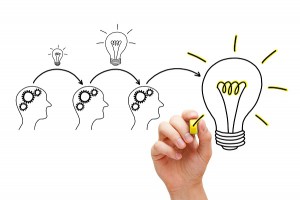Sometimes it’s easier to try being mindful than it is to describe it, so let’s start by giving it a go through a guided exercise (which is often how we ‘practice’ mindfulness in order to improve our ability to be more mindful in daily life). Give yourself 5 or 6 minutes to try this…
- Start by sitting or standing, with an upright and active posture (a bit like the Meerkat in the picture!).
For example, if you’re sitting, come away from the back of the chair and place both feet on the ground, with your hands relaxed in your lap. If you’re standing, then place your feet hip-width apart, arms relaxed by your sides. In both cases allow your back to be upright without forcing it, and try tucking in your chin so that the crown of your head is pointing towards the ceiling. Though, this isn’t a requirement. So if you’re not able to adopt this kind of position, simply adopt what for you is an alert posture.
- Relax your gaze or close your eyes.
A lot of information arrives through vision, and although you can be mindful with eyes wide open, reducing the input to your mind can be really helpful.
- Allow your attention to focus on something in the present moment, like how your feet feel on the floor.
When you are mindful, your attention is focused on something in the present moment – as opposed to thinking about what you might make for dinner, or those actions on your task list you have yet to complete.
- Notice what goes on in your mind and body, without trying to stop it, engage in it, or judge it.
If you are focused on how your feet are feeling, does the sensation of weight change. If you are wearing shoes or socks, can you feel them? What temperature are your feet? What other sensations do you notice?
Simply notice these things, be aware of them, that’s all. Our ‘doing’ mind likes to interpret – these shoes are too tight; my feet are cold, I really should get some warm socks; oh, I can’t really feel much, perhaps my veins stopped transporting blood down there; and so on, and on, and on.
So, just notice and be aware without judging what’s going on, and nothing else for the next few minutes. You might notice that thoughts seem to spring into your mind or creep up on you. And before you know it, you’re off thinking about something. When this happens (it would be unusual if it didn’t!), as soon as you notice, just go back to awareness of your feet.
That’s it for now.
That is an example of simple mindfulness practice. You were focused on the present moment, without interpreting or judging, and without need to have a specific goal in mind other than noticing. You might call it a meditation which is a common way to practice mindfulness.
The word ‘practice’ is important… mindfulness isn’t about meditation, but meditation is a common way to practice mindfulness. Two more things:
- Firstly, you can be mindful (in the present moment, without judging and interpreting) doing almost anything – running, driving, doing email, showering, making dinner, and so on. The reason we practice is that it doesn’t come naturally or easily to most of us, and by practising we can more easily be mindful whenever we choose.
- Secondly, the word ‘meditation’ is a bit like the word ‘sport’ – there are lots of different ways to do it, a number of which you would learn on a mindfulness training course.
What I haven’t talked about here is ‘why’ you might want to be more mindful (or what are the benefits). There are plenty of benefits and for one perspective on them take a look at the post ‘Why practice mindfulness‘ or ‘Why Mindfulness‘ over on my business site.
Questions or thoughts? Post them below, or get in touch!




